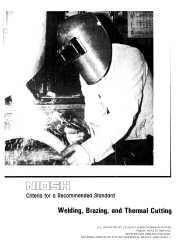Criteria for a Recommended Standard: Welding, Brazing, and Thermal Cutting
April 1988
DHHS (NIOSH) Publication Number 88-110

This criteria document on welding, brazing, and thermal cutting reviews available information on the health risks for workers in these occupations and provides criteria for eliminating or minimizing the occupational risks these workers may encounter. Evidence from epidemiologic studies and case reports of workers exposed to welding emissions clearly establishes the risk of acute and chronic respiratory disease. The major concern, however, is the excessive incidence of lung cancer among welders. A large body of evidence from regional occupational mortality data, cause control studies, and cohort studies indicates that welders generally have a 40% increase in relative risk of developing lung cancer as a result of their work experiences. The basis of this excess risk is difficult to determine given uncertainties about smoking habits, possible interactions among the various components of welding emissions, and possible exposures to other occupational carcinogens, including asbestos. The severity and prevalence of other respiratory conditions such as chronic bronchitis, pneumonia, and decrements in pulmonary function are not well characterized among welders, but these effects have been observed in both smoking and nonsmoking workers in this occupation. Excesses in morbidity and mortality among welders appear to exist even when exposures have been reported to be below current Occupational Safety and Health Administration (OSHA) permissible exposure limits (PELs) for the many individual components of welding emissions.
Criteria for a Recommended Standard: Welding, Brazing, and Thermal Cutting [PDF - 10.7 MB]
- Page last reviewed: June 6, 2014
- Page last updated: June 6, 2014
- Content source:
- National Institute for Occupational Safety and Health Education and Information Division


 ShareCompartir
ShareCompartir